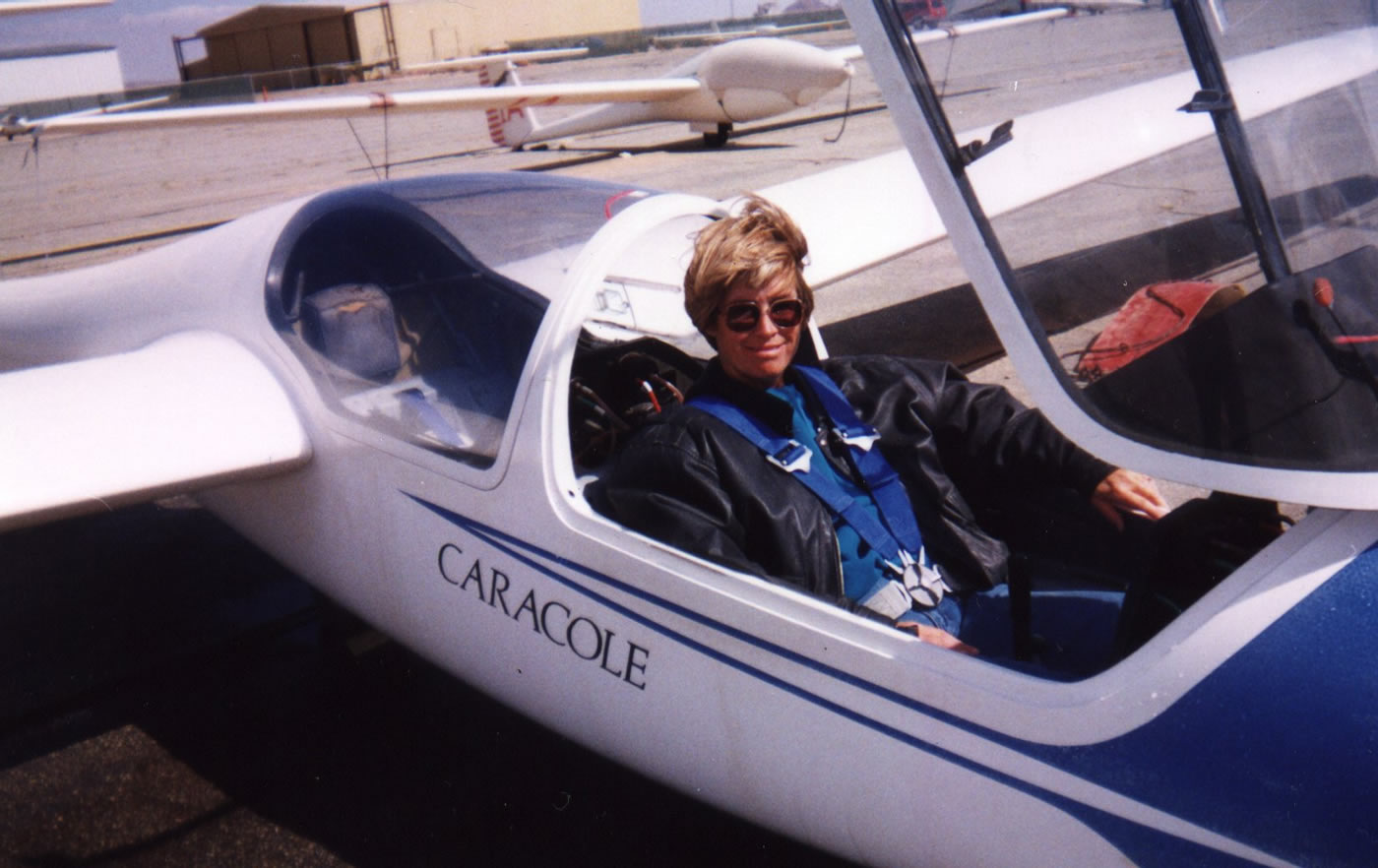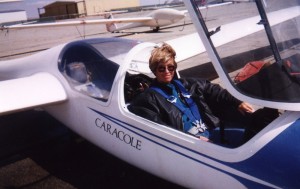By Fred “Crash” Blechman
It was calm and partly cloudy at Whiteman Airport when we took off for California City for me to revisit the site of my introduction to flying a sailplane at Caracole Soaring. It had been almost 10 years, but the memory lingered on.
Jimmy Weldon, the voice of Webster Webfoot and Yakky Doodle, was the pilot in command of his V-Tail Bonanza; I was in the right hand seat. Soon after takeoff, Jimmy flipped over the single yoke to me and set the GPS for California City Airport as I climbed the Bonanza to 5,500 feet to make it over the mountains to the north. Despite a strong wind, Jimmy made a perfect landing on 6,035 foot Runway 24 and taxied to the gas pump.
Sorry to say, when we got there, it ended up being too cold and windy to fly. However, after a nice lunch of French cuisine at the Le Bistro Restaurant in the airport’s comfortable administration building, we visited with Cindy Brickner, soaring instructor and owner of Caracole Soaring now and when I first met her almost 10 years ago.
Our flight to the airport was a lot easier—and more fun—than the long drive in September 1992 when my friend, Steve White, suggested we go soaring. It was a 90-minute drive from the San Fernando Valley, out the 118 freeway east to the 405, then a short leg to the 5, then north to Route 14, which snaked its way past Palmdale to 10 miles past Mojave, and then five miles east on a Kern County road to California City Airport—in the high desert at 2,437 feet above sea level.
Why soaring? Well, a year earlier in July 1991, I had been flying mock air combat in a small Italian Marchetti SF-260W prop-driven fighter. After lots of twisting and turning, yanking and banking in air combat maneuvering, pulling Gs long and hard, I came down from that flight with a torn retina in my left eye—which cost $2,800 to repair with laser surgery. I was 64 years old at the time, and decided that my body was no longer the same as when I was a Navy fighter pilot flying F4U Corsairs in the early 1950s! Sayonara aerobatics…
Since I’d never flown a sailplane, I went along with Steve out of curiosity. This location lays claim to offering the best year-round soaring conditions in the world. Learning to fly a sailplane is by far the safest and best way to learn the basics of flight. Even the US Air Force Academy does its primary training instruction in sailplanes. California City Airport has various types of lift throughout the year—10,000-foot-plus thermals in the summer, and a fabulous mountain wave in the winter months. The world record highest flight was 49,009 feet MSL in 1986, at California City.
Since a 20-minute introductory flight in those long-ago days was only $50 (now $80), both Steve and I decided to take rides in different sailplanes. Both were Schleicher AS-K21 sailplanes with a 58-foot wingspan and weighed 800 pounds empty. Steve’s had a 5K on the tail, so it was called “Five Kilo”; mine had a QM on the tail, and was called “Queen Mary.”
The tow plane was a Piper Pawnee flown by Chuck Griswold, a United Airlines 747 captain. My pilot was Russ Dervaes, an aerospace engineer (since deceased). Steve’s pilot was Marty Eiler, co-owner at Caracole.
After the usual checks and procedures, we were off. Climbing between 500 and 1,000 feet a minute at 65 knots (75 statute miles an hour), Russ, in the backseat, controlled the sailplane to stay directly behind and slightly above the tow plane to avoid prop wash. It only took about five minutes to get to the release altitude for this introductory scenic flight (4500 feet MSL) before Russ cleared the airspace and released the tow.
The air was smooth, and except for the rush of cooling air through the canopy vents, it was quiet. No prop noise. No vibration. With the nose slightly lowered, we were gliding at 55 knots and sinking at about 180 feet a minute. Soaring like a bird. In fact, we spotted some birds circling nearby.
“Aha,” said Russ, “a thermal. Let’s go for it!” Based on feel and experience, Russ guided the Queen Mary into a thermal that was rising faster than our sink-rate, so up we went.
That’s when Russ, knowing I was a fixed wing pilot, allowed me to take the controls.
“Just stay in this circle, and hold 55 knots with your nose position,” he said. Simple enough. I had an altimeter, a magnetic compass, an airspeed indicator, and a “variometer” (rate of climb/descent indicator) that kept climbing. Soon, we were over 6,000 feet MSL, still climbing, and getting further from the airport.
Russ finally told me to level the wings when we were headed back to the airport so we could exit the thermal and return. We had already been up for 45 minutes on this scheduled 20-minute ride. I was expecting Russ to take over the controls, but he let me continue to fly the sailplane.
Russ checked the wind direction, unlocked the spoilers, and we cleared for traffic. I watched my airspeed as we approached the airport. He let me enter the pattern for a left-hand approach to land on the 2,000 foot glider strip parallel with asphalt runway 24. I turned downwind, then turned to base, then turned on final, and made the landing. In all fairness, Russ operated the spoilers, and cautioned me just before touchdown when I started to flare out for the landing. “This is no tail-dragger. Let it settle in,” he said.
And it did, on the single wheel forward of the center of the fuselage. That was 10 years ago; what a great flight.
Caracole Soaring began operating at California City Airport in July 1990. In case you’re wondering, the name Caracole comes from the Old French/Spanish word to indicate a spiral staircase or climbing turn.
Caracole Soaring offers a scenic ride that is a tow to 3,000 feet above the ground, with an average flight time of 20 to 25 minutes, which is the “perfect flight for someone unsure they will enjoy a lesson.” For the flight, they recommend bringing a camera or (small) video cam.
If you’re thinking about taking lessons, a “first lesson” is also a tow to 3000 feet above the ground, after a description of instruments and flight controls, for an average flight of 20 to 25 minutes.
Caracole Soaring’s “First Thriller” is a tow to 4000 feet above the ground, and includes steep turns and quick speed changes. Then there’s the “Thriller Max Acro,” which is a tow to 5000 feet above ground. The mile-high flight, which requires parachutes to be worn (per FAA rules), includes the possibility of maneuvers such as loops, rolls and Immelmanns and inverted flight. Caracole Soaring offers the reassurance that pilots will discontinue aerobatics at any time during the flight, for passenger comfort! You can also request the repeat of favorite maneuvers.
For information regarding Caracole Soaring, please call
(760) 373-1019. Fred “Crash” Blechman may be contacted at fblechman@juno.com, or you can visit his website at www.expage.com/bentwings.












